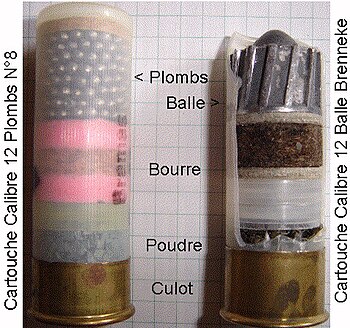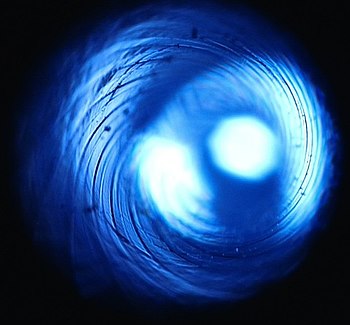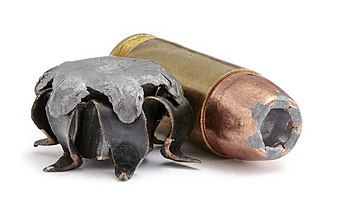| (Photo credit: Wikipedia) |
What does a firearms investigator look for on the gun itself?
* What is the overall condition of the weapon?
* Is the gun capable of being fired? Do all of the parts
* Is the gun capable of being fired? Do all of the parts
function?
* Were there any modifications made to the gun? Many are illegal.
* Were there any modifications made to the gun? Many are illegal.
* The serial number to see if it can be traced to an
owner.
What if the serial number has been removed?
Restoration of a serial number if someone filed it off is possible. A serial number can't really be filed off to completely remove trace information. In the manufacturing process the act of making the number stamp leaves permanent stress marks in the metal below. An investigator will file the area as smooth as possible then use the metal etcher called Fry's Reagent. This will dissolve the metal and expose the numbers. Because the chemical agent continues to etch the metal surface, the window for being able to see/read the number is short lived and must be watched carefully and photographed. The investigators only get one shot (no pun intended) - so better not have someone interrupt the procedure or your plot line could take a turn - they'll never get the chance back.
What if an investigator finds a bullet or casing?
When an investigator finds:
* tool marks
* firearms
* bullets
* cartridge cases
at a crime scene, they are investigated in much the same way and usually by the same experts.
Blog Link - Tool Mark Forensics
By the way, Firearms examination and ballistics are NOT the same thing
Ballistics is a form of physics that studies the way any object travels - this could be anything from a soccer ball to a paper airplane. In forensics it usually is referring to bullets and shotgun shells.
* firearms
* bullets
* cartridge cases
at a crime scene, they are investigated in much the same way and usually by the same experts.
Blog Link - Tool Mark Forensics
By the way, Firearms examination and ballistics are NOT the same thing
Ballistics is a form of physics that studies the way any object travels - this could be anything from a soccer ball to a paper airplane. In forensics it usually is referring to bullets and shotgun shells.
Let's start with some basics:
Investigators will first determine which group of firearms was used.
5 Main Groups of Fire Arms
* Pistols/Handguns (Handgun Information Blog Link)
`revolver cartridge casing of shot bullet remains in the chamber
5 Main Groups of Fire Arms
* Pistols/Handguns (Handgun Information Blog Link)
`revolver cartridge casing of shot bullet remains in the chamber
and must be emptied.
`single shot
`double shot
`semi-automatic
`automatic
* Shotguns
`double shot
`semi-automatic
* Shotguns
| Cartouche (Photo credit: Wikipedia) |
`They DO NOT shoot
bullets they shoot
buckshot, pellets, or
slugs (a slug has a single
projectile usually a soft
metal like lead that is
loaded into a shotgun
shell)
* Machine guns
* Machine guns
`automatic weapons
`fed ammo from a magazine or a belt
`powerful recoil
`get very hot so they need to be mounted on a stand
*Submachine Guns
`Fully automatic
`Can be hand held
`Can be hand held
The Investigators will also look at bullets recovered from a crime scene or a victim's body and/or the casings to see if a bullet came from the barrel of a certain type of gun.
The Gun Barrel
* a barrel of a gun is produced by hollowing out a solid metal bar.
* a barrel of a gun is produced by hollowing out a solid metal bar.
The drill that does this will leave random tool marks on the inside.
After the barrel is hollowed out then a series of
After the barrel is hollowed out then a series of
grooves are made to the inside these are called rifling.
* The flat places are called lands
* The space between them are called grooves
* The flat places are called lands
* The space between them are called grooves
| This is an image of a 35 remington caliber, microgroove rifled barrel manufactured by the marlin firearms company. it shows a 20 land and groove barrel with a right hand twist. The image was taken with a Nikon DX1 camera using f22 and a 1/30 ss. The bore of the barrel was lighted with a standard bore light. --Rickochet 12:59, 9 July 2006 (UTC) (Photo credit: Wikipedia) |
Now, the verb rifling means the spin that is put on a flying object. A baseball player, for example, will rifle the ball to make it spin so that the object stays on a true trajectory. (HINT: Shotgun barrels are NOT rifled they are smooth-bore)
When a bullet is fired through the barrel the bullet takes on the impression of the barrel's rifling. The lands on the barrel will make grooves on the bullet and the grooves will make raised spaces. Think of this like an old-time photographic negative.
Different manufacturers use different rifling specifications. For example: all Smith and Wesson .32 caliber revolvers have 5 lands and 5 grooves that twist right. Maybe the make of the gun twists left or has 9 lands. A firearms investigator can then look at the bullet and narrow down the gun manufacturer.
Caliber - the inside diameter measurement of a guns barrel measured between the lands (raised part of the rifling). We see these written as either hundredths of an inch or in mm.
Gauge - the measurement of a shotgun barrel (there's math formula for this that has to do with number of pellets that can fit into a pound)
The size of the bullet that was shot therefore can help determine:
1) Was it a smooth-bore or a rifled gun
2) What size barrel did the gun have? was it a .22? a 9mm? a .45?
Video Quick Study (6:34) Demonstration of a FBI firearm investigation
Type of gun is class evidence. It cannot tie a gun to a specific crime. But microscopic anomalies in production as well as use will make one gun barrel specifically different from another - as different as fingerprints. So when the bullet travels through the barrel the lands and grooves as well as the microscopic anomalies get transferred. Now they can tie a specific bullet to a specific gun. To do this
* The gun in question is examined in the lab
* The same kind of bullet is used (see bullet tutorial for different
kinds of bullets that could be chosen for a gun such as hollow
point FMJ Blog Link) from the same manufacturer.
* The bullet is fired into a test tank
* The crime scene evidentiary bullet is compared to the test bullet
* The bullet is fired into a test tank
* The crime scene evidentiary bullet is compared to the test bullet
by computers or under high-powered microscopes
* Full metal jacketed bullets tend to be easiest to handle with more
* Full metal jacketed bullets tend to be easiest to handle with more
consistent striated details.
Video Quick Study (1:21) of a bullet being fired.
Video Quick Study (2:28) NCSTL does a quick overview of firearm investigation
Video Quick Study (8:12) Showing a test tank for gathering evidence of the striations of a gun in question
Video Quick Study (2:28) NCSTL does a quick overview of firearm investigation
Video Quick Study (8:12) Showing a test tank for gathering evidence of the striations of a gun in question
The ATF developed the Integrated Ballistics Identification System (IBIS)
Video Quick Study (8:57) This shows you the holes that you can use in your plot, including how to change the barrel quickly and easily by just cleaning it with an abrasive cleaning product and thus change the microscopic tool marks. (Fair warning - NRA sponsored so this video does have it's own agenda)
Now on to the spent bullet and shell cases
The cases on a scene often have the manufacturer information stamped right on them. They may also have the markings from the firing pin (the tiny piece that hits the end of the round to send it down the barrel).
If a bullet or casing is found at the scene the investigator has to take great care not to damage any of the microscopic markings on the evidence. This means they may have to cut a section out of a wall if the bullet is embedded to take the whole thing back to the lab for the investigators to work on.
The gun, casings, and bullets will all be checked for fingerprints as well. (fingerprint article Blog Link). They will also look for trace evidence such as lint or hair.
And finally, a look at propellants and primers:
Inside of a round there is the bullet, the propellant and at the bottom a little bit of primer. The firing pin strikes the primer, igniting the propellant and forcing the round down the barrel of the gun.
IBIS is the computer system that can match the known barrel identification markings and match them to a bullet's markings. In this way various crimes can be linked to a single gun.
Video Quick Study (1:43)
Video Quick Study (4:29)
Video Quick Study (7:11)
This computer is not the "silver bullet" Once the computer finds a match it still has to be manually examined by an investigator - your investigation team
Video Quick Study (1:43)
| (Photo credit: Wikipedia) |
Video Quick Study (4:29)
Video Quick Study (7:11)
This computer is not the "silver bullet" Once the computer finds a match it still has to be manually examined by an investigator - your investigation team
skipped this step? Might come
out in your court case scene - did
you want the perp to walk?
Video Quick Study (8:57) This shows you the holes that you can use in your plot, including how to change the barrel quickly and easily by just cleaning it with an abrasive cleaning product and thus change the microscopic tool marks. (Fair warning - NRA sponsored so this video does have it's own agenda)
Now on to the spent bullet and shell cases
The cases on a scene often have the manufacturer information stamped right on them. They may also have the markings from the firing pin (the tiny piece that hits the end of the round to send it down the barrel).
If a bullet or casing is found at the scene the investigator has to take great care not to damage any of the microscopic markings on the evidence. This means they may have to cut a section out of a wall if the bullet is embedded to take the whole thing back to the lab for the investigators to work on.
The gun, casings, and bullets will all be checked for fingerprints as well. (fingerprint article Blog Link). They will also look for trace evidence such as lint or hair.
And finally, a look at propellants and primers:
Inside of a round there is the bullet, the propellant and at the bottom a little bit of primer. The firing pin strikes the primer, igniting the propellant and forcing the round down the barrel of the gun.
| 7N1 bullet cross sections (Photo credit: Wikipedia) |
GSR - Gunshot residue
* Partially burned and unburned powder
* Soot
* Lead
* Vapors
Because GSR comes out in a geometric configuration as it leaves the barrel, if the target was within a yard of the gunshot, then investigators can determine how far away the gun was held.
GSR gets everywhere - on the victim on the shooter and in the environment (lead, barium, and antimony). Can be removed with soap and water.
| .40S&W cartridge next to expanded hollow point bullet. (Photo credit: Wikipedia) |







